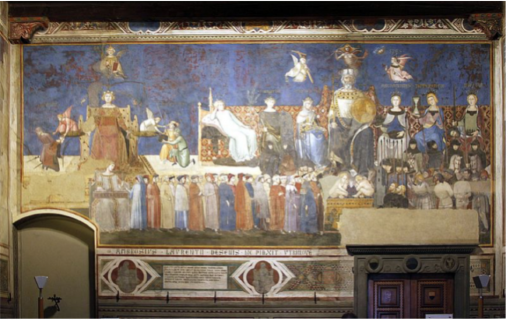This is the 23st episode of a series 25 building blocks to create better streets, neighbourhoods, and cities. Its topic is the way how the quality of the living environment benefits from good governance.
In 1339 Ambrogio Lorenzetti completed his famous series of six paintings in the town hall of the Italian city of Siena: The Allegory of Good and Bad Government. The image above refers to the characteristics of governance: Putting the interests of citizens first, renouncing self-interest, helpfulness, and justice. These characteristics still apply.
Rooted in the community
The starting point of urban policy is a long-term vision on the development of the city that is tailored to the needs and wishes of citizens, as they become manifest within and beyond the institutional channels of representative democracy. In policies that are rooted in the community, knowledge, experiences, and actions of those involved are also addressed. Each city has a pool of experts in every field; many are prepared to commit themselves to the future of their hometown.
Participation
Governance goes beyond elections, representative bodies, following proper procedures and enforcing the law. An essential feature is that citizens can trust that the government protects their interests and that their voices are heard. The municipality of Amsterdam has access to a broad range of instruments: co-design, Initiating a referendum, subsiding local initiatives, neighbourhood law, including the 'right to challenge' and neighbourhood budgets. I will deal with participation in the next post.
Two-way communication
Barcelona and Madrid both use technical means to give citizens a voice and to make this voice heard in policy. Barcelona developed the platform Decidem (which means 'We decide' in Catalan) and Madrid made available Decide Madrid ('Madrid decides'). Both platforms provide citizens with information about the policy, allow them to put topics on the policy agenda, start discussions, change policy proposals, and issue voting recommendations for the city council.
Madrid has developed its participatory electronic environment together with CONSUL, a Madrid-based company. CONSUL enables cities to organize citizen participation on the internet. The package is very extensive. The software and its use is free. Consul is in use in 130 cities and organizations in 33 countries and has reached some 90 million citizens worldwide.
City management
Each city offers a range of services and facilities, varying from the fire brigade, police, health services, municipal cleaning services to 'Call and repair' lines, enabling residents to report defects, vandalism, damage, or neglect. Nuisance has many sources: non-functioning bridges, traffic lights, behavior of fellow citizens, young and old, traffic, aircraft noise and neighbours. In many cases, the police are called upon, but they are too often unable or unwilling to intervene because other work is considered more urgent. This is detrimental to citizens' confidence in 'politics' and seriously detracts from the quality of the living environment.
Resilience
Cities encounter disasters and chronic problems that can take decades to resolve. Resilience is needed to cope and includes measures that reduce the consequences of chronic stress (e.g., communal violence) and - if possible - acute shocks (e.g., floods) and eliminate their occurrence through measures 'at the source.'
For an adequate approach to disasters, the fire brigade, police, and ambulances work together and involve citizens. This cooperation must be learned and built up through practice, improvisation and trust and is not created through a hierarchical chain of command.
Follow the link below to find an overview of all articles.






I absolutely agree. Open and clean still dominates city planning
It's amazing how much difference some obfiscation with trees or other items can make to a street by providing depth.
There's nothing sadder then driving through a neighbourhood of boxes in a Dutch suburb. With a little thought and creativity it's possible to create depth and therefore intrigue and beauty.